Good food in Boston
Yesterday was my first relaxing day in a long time (I’ve been finishing up my semester). It started off with one of the best meals I’ve ever had, in Boston’s North End. My friend John has been telling me all year about a pastry shop there that has biscotti that “could possibly rival your mom’s.” He’s wrong, but! I love pastries, and there was no way I was going to let him move away without first going to Modern Pastry together.
Around noon, we took the T up to the Government Center stop on the Green Line, and wandered up to Hanover Street (check out those nice 3-D buildings on Google Maps). Wandering around, I finally felt I was in a part of Boston with some real personality… people sitting at tables along the streets muttering in Bostonese, big trucks parked in very narrow roads with people busily unloading food-related items, cops on horseback…
I could go on but I’m just going to cut to the chase and talk about the food. We just wandered into a restaurant that looked nice and cozy, called Trattoria il Panino. When the waitress told me the special was a risotto with artichoke hearts, truffles, and buffalo mozzarella, there really was no way I was not going to order it. Here it is:
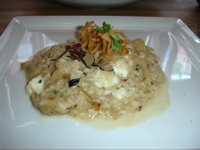
Amazingly delicious. Just thinking about it now makes my leg twitch. So creamy, the artichokes were cooked perfectly, and the flavor of the truffles and the crunch of the onions… omfg. I think that perhaps they have some very handsome children in the back, crying three tears into every serving. And, only $15! (“Maybe I really could eat this every single day.”)
On an infinitely less important note, John got a crab with linguini in it, and extra utensils:
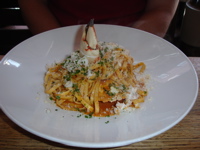
Dessert was, as promised, at Modern Pastry. I asked what was the most popular dessert, and the girl immediately said “cannoli”. So I got a chocolate-dipped one with sugar on top. It was tasty, and my fingers smelled awesome all day after that.
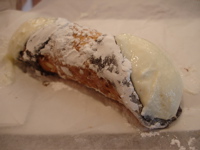
Bach: an illusion of two violins
There is a concept in auditory scene analysis (how we separate and group all the sound sources we might hear at once, like the cocktail party effect) called “auditory streaming”. It just means that we will tend to group sounds of similar pitch into the same perceived object. For example, I could play you a trill on a piano (so, two notes not separated much in pitch), and you would hear it all as one stream. If instead I played two notes separated much more in pitch, you would interpret that as two different streams.
Bach uses this idea in his Prelude for Partita Number 3 for solo violin, to create the illusion of multiple violins. Below is a video of Jascha Heifetz playing the Prelude (http://www.youtube.com/watch?v=ruu1JqRPPic). There are many points during the piece when the violinist bounces back and forth between low and high pitches so quickly that it sounds like two violins are playing. Best places in the video to hear this: 2:30-2:43, 2:59-3:03, and 2:08-2:13.
What’s a radial tire swing?
On Friday I was invited by one Mark F to play on the tire swing at Senior House. We walked over there from the lab, through the house and out onto the back courtyard. There, hanging from a large tree, was a tire swing. Except… the rope was so long that the tire was sitting on the ground. “But Mark, the rope’s too long.” “Yep,” he said, with no sign of any concern. I was kicking around some leaves right next to it, while I thought Mark was adjusting the rope, when suddenly he just said, “This tire swing is different, because it swings radially!” And he took off running with the tire swing in tow.
Turns out that this tire swing works just like tetherball, where you are the ball, and the tree is the pole. You run around the tree, with the rope taught, and run and run until at some point your feet must leave the ground (jumping intentionally at this point is recommended). Then you fly through the air, the rope wrapping around the tree, and you’re pulled higher and higher, closer and closer, until you are running around the tree itself. Mark has this skill perfected, and he runs around and up the tree, and then he jumps out, and into the unwrapping spin. He wraps and unwraps, over and over, never slowing down. It really was insane.
I tried it three times. The first time I ended up skidding backwards on the concrete, on my head and upper back. The second time, I skinned my shoulder on the tree (turns out it’s pretty important to keep facing the tree; otherwise you end up wrapping yourself very quickly into it. The third time, I managed to actually step along the tree at the tightest part of the swing cycle, push out gently, and unwrap, eventually coming to rest and damn proud of it.
Indulgence is a good thing
Brent and I spent a good part of the day yesterday romping around, doing mostly whatever we wanted. Brent declared it officially our Day of Indulgence when we sat down to have our ice creams at Toscanini’s. With fresh bellies, we had an afternoon of shopping for shoes, eating burritos, and watching Spiderman 3. And it’s the best time I’ve had out in Cambridge in a long while. I need to remember to try to take more breaks like that. thanks, brento!
Spirals, scoops, sailing
Today was awesome.
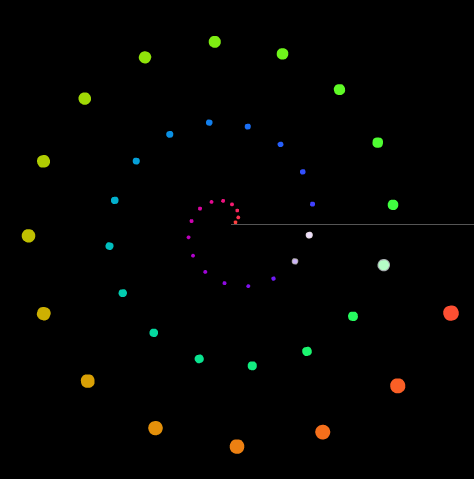 I met a fun guy named Ned Gulley, who works at Mathworks. He showed me this great thing: Fermat’s spiral. He introduced me to the spiral by pointing out that KrazyDad did some amazing musical visualizations using this pattern. You definitely should look at these two in particular, to see the pattern at work:
I met a fun guy named Ned Gulley, who works at Mathworks. He showed me this great thing: Fermat’s spiral. He introduced me to the spiral by pointing out that KrazyDad did some amazing musical visualizations using this pattern. You definitely should look at these two in particular, to see the pattern at work:
- Whitney Music Box
(This reminds me of the Electroplankton Nintendo DS game.) - Fibonacci Logos screensaver from this post: “The motion in this screensaver is actually quite simple — if you look at each disc, you’ll see that it is just sitting in place, rotating at a constant rate. However, each disc spins slightly faster than the next largest one, which produces a series of very interesting patterns over about a 10 minute cycle.”
Very cool. Thank you, Ned!
- Whitney Music Box
- After dinner with my group, we went to one of the most comfy places in Cambridge, Toscanini’s ice cream, and I got the best flavor: ginger snap molasses. I asked my favorite ice cream guy how many scoops of ice cream is in each one of those big tubs. He said, “Well, I’m not totally sure… but… there are usually about three gallons of ice cream in each one… and each scoop is 6 ounces. ‘2 scoops’ is 8-10 ounces.”
First off, “2 scoops” ain’t 2 scoops! Who knew. (…although “2 scoops” doesn’t cost twice as much either, so I’m not complaining.)
I told him I would figure out how many scoops were in a tub and let him know. After some argument at the table over how many cups/ounces/monkeys are in how many gallons, we decided that the answer is about 75 scoops. (128 oz. x 3 gallons / 5 oz. = 75. ish.)
- Sailing and learning to sail at MIT are FREE! I hope to try it out this summer.
Riding a Segway
I spent almost all of my day at the Media Lab’s h2.0 bonanza, where we (in Frank Moss‘s words) explore what happens “when people begin to merge with the technologies they’ve created”. And I have all kinds of things to say about the crazy shit I saw, both good and bad, but I’ll have to write about that later. For now, I just want to say that I got to try a Segway for the first time today!
I only got about 60 seconds on the thing, and it went something like this:
0-7 seconds: Complete mistrust of the machine. “This thing is totally going to fall over.” I lean, start feeling like I will fall, then overcorrect, resulting in a jerky forward motion. Forward, stop, forward, stop, f-f-forward… backwards… stop.
8-20 seconds: “Ok, maybe not. Ohhhh, I see… I can… yeah! Lean forwards, lean back. Hey, this is kinda cool.”
21-60 seconds: GLEE!

soundsieve [v1.0]
Here’s a screenshot from the thing I’ve been working on for most of the past week:
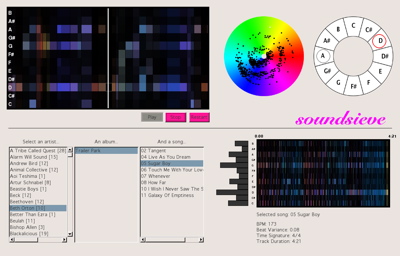
I was getting it ready to show sponsors this week at the Media Lab. People responded really well, and it was lots of fun talking to people and hearing what they had to say. I already have a long list of things I want to do with it over the summer (starting with making it an iTunes plugin).
Here’s some text from the handout:
soundsieve is a music visualizer that takes the intrinsic qualities of a musical piece – pitch, time, and timbre – and makes their patterns readily apparent in a visual manner. For example, you can quickly pick out repeating themes, chords, and complexity from the pictures and video.
It’s a new, informative way to look at your music. It allows you to explore the audio structure of any song, and will be a new way to interact with your whole music library, enabling you to navigate the entire space of musical sound.
The current form of soundsieve is a music browser (like iTunes), that lets you see visual representations of any MP3 you own. You select a song, and see a set of pictures of the piece’s audio structure. Then you can choose to play the song, and see real-time visualizations accompanying the piece.
I posted some early documentation on the project, but I’ll have to go through and update it soon.
Things currently on my desk
I just felt like making a long list of something.
At 9pm, May 8, 2007:
- a stick
- binder with Tristan Jehan‘s thesis
- empty reused Poland Spring water container, 0.5 L
- vinyl folders with papers inside
- The Tech from last week
- scissors
- wasabi peas in Ziploc, from mom
- lomograph fisheye
- Grado headphones
- Magic card: Cinder Crawler, 1/2 creature (“Summon salamander”)
- Sportea box, empty, to recycle (best webpage ever, btw)
- plastic jar of Aquaphor lotion
- business card box, with an unusable number of my cards inside
- blank cards with Japanese floral print
- Godzilla sticker sheet, mostly used
- lasercammed icons
- Jackass wristband
- Neutrogena hand cream
- 3 marimo in glass cube containers
- resistor, 330 ohms
- black plastic knife
- simplicity notepad
- two toys: sparkly and two-hands-up guy (fluffy might remember who makes these?)
- post-its
- Ziploc with white LEDs inside
- Hammerfall DSP Multiface
- 1.5″ of 1/4″ aluminum dowel
- an unidentified cable
- big brown mug
- swimsuit, goggles, lock, and cap, in Ziploc (gallon-size zip-top)
- black electrical tape
- 2 white plastic forks
- stapler
Asparagus pee
Sadly, I don’t have time to write much today. But I *did* eat asparagus with dinner, and my pee smells obnoxious. I poked around online to see why, and here’s my favorite answer (even so, not so satisfying an answer):
The Straight Dope: Why does asparagus make your pee smell funny?
…Benjamin Franklin, in a wide-ranging discussion of bodily discharges, once noted, “a few stems of asparagus eaten shall give our urine a disagreeable odor; and a pill of turpentine no bigger than a pea shall bestow upon it the pleasing smell of violets.”
It is said that in a venerable British men’s club there is a sign reading “DURING THE ASPARAGUS SEASON MEMBERS ARE REQUESTED NOT TO RELIEVE THEMSELVES IN THE HATSTAND.”
(…And I’m still wondering how it can start smelling so bad so quickly! Today must have been 10-15 minutes.)
Hedy Lamarr and frequency hopping
 We’ve been learning about radio frequency transmission in sensors class, and today Ari told us about how actress Hedy Lamarr and composer George Antheil came up with the idea of frequency hopping to avoid jamming of radio-controlled torpedoes during WWII. The best part was their idea to use a roll from a player piano, on both the torpedo and transmitter, to change the transmission frequencies. I had fun looking at their patent here.
We’ve been learning about radio frequency transmission in sensors class, and today Ari told us about how actress Hedy Lamarr and composer George Antheil came up with the idea of frequency hopping to avoid jamming of radio-controlled torpedoes during WWII. The best part was their idea to use a roll from a player piano, on both the torpedo and transmitter, to change the transmission frequencies. I had fun looking at their patent here.
From http://hypatiamaze.org/h_lamarr/scigrrl.html:
Hedy knew that “guided” torpedos were much more effective hitting a target, a ship at sea for example. The problem was that radio-controlled torpedos could easily be jammed by the enemy. Neither she nor Antheil were scientists, but one afternoon she realized “we’re talking and changing frequencies” all the time. At that moment, the concept of frequency-hopping was born.
Antheil gave Lamarr most of the credit, but he supplied the player piano technique. Using a modified piano roll in both the torpedo and the transmitter, the changing frequencies would always be in synch. A constantly changing frequency cannot be jammed.
They offered their patented device to the U.S. military then at war with Germany and Japan. Their only goal was to stop the Nazis. Unfortunately or predictably, the military establishment did not take them or their novel invention seriously. Their device was never put to use during World War II.
From http://en.wikipedia.org/wiki/Hedy_Lamarr#Frequency-hopped_spread_spectrum_invention:
Lamarr’s frequency-hopping idea served as the basis for modern spread-spectrum communication technology used in devices ranging from cordless telephones to WiFi Internet connections.
Lamarr was awarded by the EFF in 1997 for her contributions to this invention.